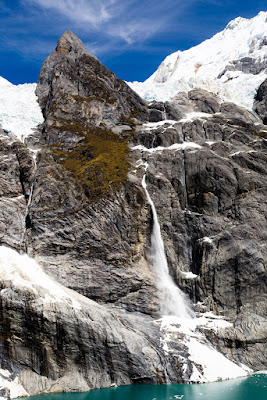Week 7: 52 Places to Go
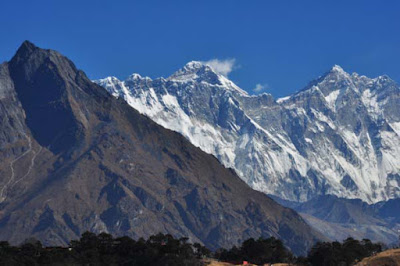 |
| Mount
Everest (in the middle) beyond the Hotel Everest View (in the trees) |
My friend and fellow children’s book author Caroline Hatton, one of the most adventurist travelers I know, went
trekking in the Everest region of the Nepal Himalaya in November 2018. Here is her report of the trip. She took
all but one of the photos in this post. For info about her books, visit www.carolinehattonauthor.com.
I
didn’t know that rooms are not heated, even in freezing November temperatures.
When I had read about “tea house” lodging, I had pictured rooms above hot
kitchens and warm dining rooms. But even the kitchen staff often wore insulated
jackets and fleece hats. And dining room stoves were lit for only a couple of
hours at dinner time, with people huddled around like Emperor penguins in an
Antarctic blizzard. My sleeping bag, rated for 0 oF (~ -17 oC),
saved my life.
Why
go in November? Because it’s the second most popular month, after October, for
Himalaya treks. As the days pass, it’s less likely to rain, but the clear
weather grows colder. It was a good trade-off to avoid peak crowds.
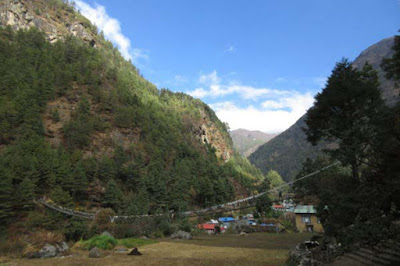 |
| The trail crosses the river between Phakding and
Namche Bazaar
|
My
sightseeing itinerary along the only trail toward Mount Everest, through the
homeland of the Sherpas, was standard. I flew from Kathmandu to Lukla, hiked to
Phakding and Namche Bazaar, back to Lukla, and flew back to Kathmandu. Namche
is ~13 miles (~21 km) from Lukla, or less than a third of the way to Everest
Base Camp. Yet I saw Everest from one point near the trail between Phakding and
Namche, and the following morning from above Namche.
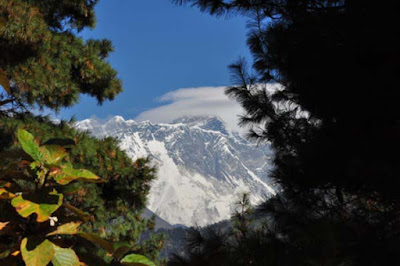 |
| First glimpse of Everest (with top in cloud)
between Phakding and Namche Bazaar |
I
slept no higher than 11,300 ft (~ 3444 m) in Namche, a familiar
altitude after decades of California Sierra Nevada backpacking. No altitude
sickness, no rock climbing, but also no wilderness or isolation on the ancient
trade route between villages. This classic “Everest Panorama Trek” takes at
least five days round-trip from Kathmandu.
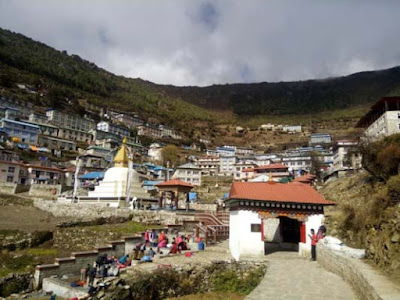 |
| Arriving in Namche Bazaar. Photo courtesy of
guide Sangam Shresta |
In
contrast to the nightly cold, my first “hot shower” was heaven, but the instant
I turned the water off, I was plunged back in ambient room air, barely above
freezing. Even though I dried myself and got dressed as fast as possible, my
feet turned purple before I could get socks on. No more showers for me! Why
bother anyway, since I had only one shirt and one pair of pants for six days?
Thank goodness for wet wipes, perfect for keeping important parts sufficiently
clean.
On
several occasions when I was outside, teeth-chattering temperatures became
forever associated with favorite sights: peak tips ablaze at sunrise, clouds on
fire at sunset, or racing fog tearing open to reveal a snowy height in blinding
sun. Then it seemed worth freezing to the bone in exchange for the hope of
getting a good photo. My camera’s Vibration Reduction Technology neutralized my
shivering.
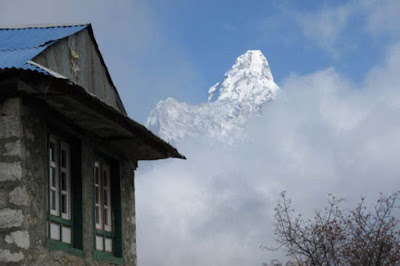 |
| Mount
Ama Dablam (22,349 ft ~ 6812 m) from the Sherpa village of Khumjung
(12,402 ft ~3780 m) |
The
notion of hiking toward Everest, which had existed solely in my imagination as
a reader, became reality. A thrill that had involved mostly brain cells became
physical, from head to toes, skin to muscles to heart and lungs and guts, with
the universe pressing against me with sun glare, gravity, and cold, shaping my
experience, reshaping me.
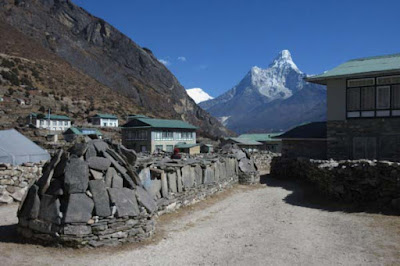 |
| Buddhist mani stones (inscribed with mantras) in
a Khumjung street
|
On
my favorite day, I hiked a loop from Namche to the village of Khumjung. I saw
Everest for the second time, when I stood by the statue of Tenzing Norgay, who summited
it with Edmund Hillary in 1953. The trail soon led straight up a steep slope. Loaded
yaks marched straight down without hesitating or slipping. At the Hotel Everest
View, I sipped the obligatory tea on the terrace, taking in the clear sight of the
top of the world. Onward through fir forest, with the snow capped panorama
scrolling around me, I thought nothing could ever make me feel as exalted. Then
I saw Khumjung, with its big gray stone houses and green roofs and stone-walled
fields in between, spread in the warm sun.
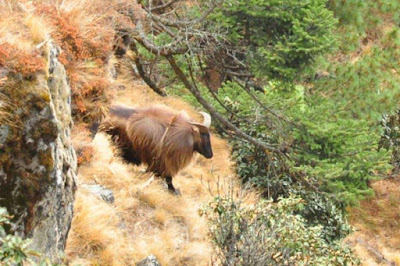 |
| Wild Himalayan tahr (Hemitragus jemlahicus)
or “lion goat” |
On
the way back to Namche, wild Himalayan tahrs (Hemitragus jemlahicus),
nicknamed “lion goats” because of their mane, were resting on grassy slopes. That
day, on that side trip, I didn’t see too many other visitors.
In
contrast, on the main trail toward and from Everest, traffic was lively with international
athletes competing in the six-day Everest Trail Race from Everest
Base Camp down to Lukla (not to be confused with runners in the Everest Marathon in May, also down
from Everest Base Camp, but only to Namche Bazaar), climbers, photographers,
plain old trekkers, yak or mule caravans lugging their stuff, or bringing food
and fuel up the mountains, and assorted humans needing to find or lose themselves
in the epic landscape.
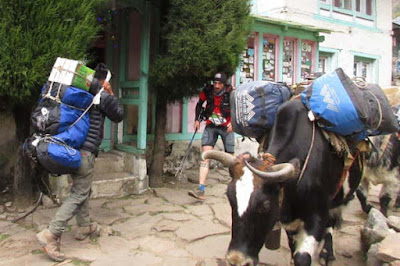 |
| Yak, race competitor, and porter on trail
through Jorsale |
Trail
noises were a mix of trekking pole taps on stone, gravel, or dirt, international
chatter among walkers, the pastoral melody of yak and mule bells, the whistles
and shouts of their handlers, bouncy popular Nepali songs squirting out of cell
phones strapped to young porters speeding along with heavy loads, and
helicopters pounding up and down the valley with sightseers, supplies, and
perhaps the occasional evacuee. As a writer, I also noted smells: eggs cooking,
stove smoke, incense, kerosene, and tourists and porters who skipped showers.
Back
in Lukla, my bedroom was on the ground level, two floors below the kitchen and
dining-room. The chilly temperatures must have dropped by an order of magnitude
per floor. After dinner, facing this descent, one trip mate with gaze fixed and
jaws set, the embodiment of unshakeable determination, said, “Down to the
permafrost!” Another grumbled, “What do you call hell when it’s freezing?”
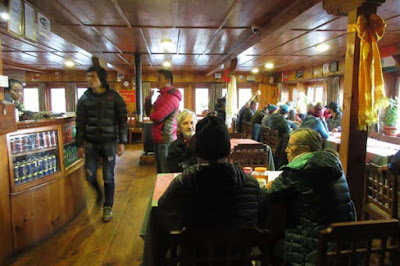 |
| Lukla:
lodge dining room with black stove |
Still,
compared to my Poon Hill trek below the Annapurna, the other most visited Nepal
Himalaya region, I liked this Everest region trek better because I found it
easier and prettier. Trails had far fewer stone steps, let alone extra-high
ones, the higher altitude meant cooler days, more evergreen than deciduous
trees, and yaks instead of buffaloes, though I love both animals, and the
highest mountains looked closer, which was more exhilarating.
Back
home in Los Angeles, the following winter I thought of the Sherpas conserving
resources, and set my thermostat down to 60 oF (~15 oC)
or turned the heater off. It’s as if the stirring splendor of the Himalayas lit
a fire inside me, which I can turn to for warmth and inspiration.
For more info
My
excellent trip organizer, Adventure Treks Nepal, provided an
excellent guide, Sangam Shresta, and two fine porters for our group of four.
Detailed trail descriptions can be
found in the Lonely Planet printed guide book, and the essential parameters and
profile are available online:
More posts at The Intrepid Tourist about Caroline Hatton's trip to Nepal:
All text and photos copyright Caroline Arnold
www.theintrepidtourist.blogspot.com






